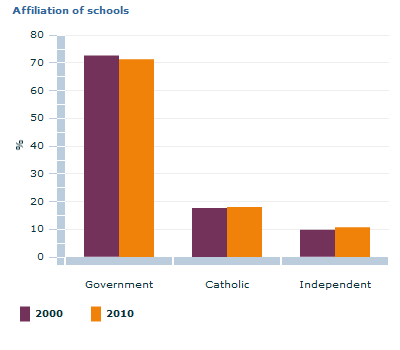4102.0 - Australian Social Trends, Sep 2011
ARCHIVED ISSUE Released at 11:30 AM (CANBERRA TIME) 21/09/2011
Page tools:
 Print Page Print Page
 Print All Print All
| ||||||||||||||||||||||||||||||||||||||||||||||||||||||||||||||||||||||||||||||||||||||||||||||||||||||||||||||||||||||||||||||||||||||||||||||||||||||||||||||||||||||||||||||||||||||||||||||||||||||||||||||||||||
CONTENTS Article - Introduction - Schools - Students - Staffing - Government funding - Pathways - Looking ahead Additional topics - Aboriginal and Torres Strait Islander Students Explanatory information - Data sources and definitions - Pathway definitions - Endnotes INTRODUCTION Schools aim to assist students to gain knowledge and skills, develop their talents and self-confidence, and increase their ability to contribute to economic development. Schools are differentiated by the type and level of education they provide and their ownership and management. (Endnote 1) Both government and non-government schools have existed in Australia since 1848. While government schools continue to educate the majority of Australian students, over the past decade the number of student enrolments and the number of teaching staff have grown at a faster rate in non-government schools than in government schools. Australian schools have continued to generate public interest. In April 2010, the Australian Government announced the Review of Funding for Schooling. The review will consider how schools are funded and lay the foundation for ongoing investment in the school sector. (Endnote 2) There is also an increasing interest in student performance, partly driven by the advent of the My School website in January 2010. My School provides comparisons of school’s students’ performances and reports financial information for each school. (Endnote 3) This article examines changes over time in the number of government and non-government schools, student enrolments and teaching staff, as well as government school funding. It also explores education outcomes for young adults (15-24 years) who last attended government or non-government schools. SCHOOLS In 2010, there were a total of 9,468 schools across Australia, a decrease of 1.4% since 2000. Of these, seven in ten (71%) were government schools. Three in every five (62%) non-government schools were Catholic and nearly two in five (37%) were Independent schools. Over the past decade there has been a decline in the number of government schools in Australia, while the number of non-government schools has increased. Between 2000 and 2010, government schools decreased by 223 - including a comparatively large drop of 59 schools between 2009 and 2010. Part of this decrease can be attributed to decisions affecting structural changes of schools, for example, amalgamations of secondary schools so that there are two campuses for one school rather than two schools. So while the number of government schools has decreased, the number of students enrolled in government schools has still increased over the past decade (by 1.3%). Over the same period, the number of non-government schools increased by 91, mainly driven by the rise in numbers of Independent schools (79 since 2000). However, there has been a slight decrease in Independent schools since 2008 (from 1,024 to 1,017). State and territory differences Between 2000 and 2010, the number of government schools decreased in most states and territories, while the number of non-government schools increased. In 2010, the Australian Capital Territory had the greatest proportion of non-government schools (35%), followed by Victoria (31%). This was mainly driven by the high proportion of Catholic schools in both the Australian Capital Territory (24%) and Victoria (22%). Independent schools made up around 10-13% of schools across all the states and territories. The Northern Territory had the lowest proportion of non-government schools (19%). This reflected the same pattern a decade earlier. AFFILIATION OF SCHOOLS IN EACH STATE AND TERRITORY - 2010 This will be replaced by the swf. 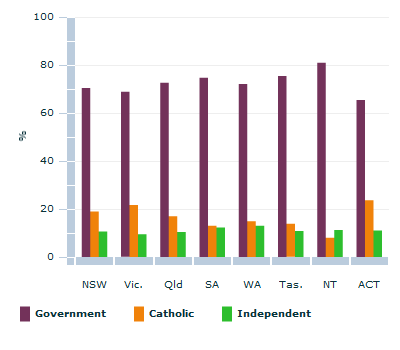 STUDENTS In 2010, there were 3.5 million students formally enrolled in all Australian schools (an increase of 7% since 2000). Of these students, seven in ten (66%) were enrolled in government schools, two in ten (20%) in Catholic schools and one in ten (14%) in Independent schools (compared with 69%, 20% and 11% respectively in 2000). Although government schools continue to educate the majority of students in Australia, the number of students enrolled in non-government schools has been increasing at a faster rate over the last decade. Since 2000, Catholic and Independent schools had the largest proportional increases in the number of students (11% and 37% respectively) while the number of students in government schools increased by only 1.3%. In 2010, there was little difference between the proportions of male and female students enrolled in government and non-government schools. Disability or health conditions The ABS 2009 Survey of Education and Training estimated that there were around 135,000 students, aged 15 years and over, who had a disability or long term health condition, for example asthma or a mental health condition. There was no significant difference between these students attending government schools (17%), Catholic schools (14%) or Independent schools (12%). SCHOOL AFFILIATION OF STUDENTS - 2000 AND 2010 This will be replaced by the swf. 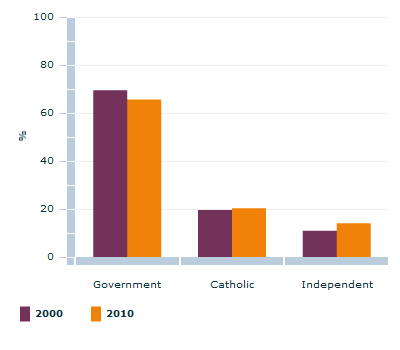 In primary and secondary schools In 2010, around two million students were enrolled in primary schools and around 1.5 million students were enrolled in secondary schools. A higher proportion of students were enrolled in government primary (69%) and secondary (61%) schools than students enrolled in non-government primary and secondary schools. The proportion of students enrolled in Catholic and Independent schools was lower in primary schools (19% and 11% respectively) compared with secondary schools (22% and 17% respectively). Many students may not remain in one particular type of school (government or non-government) for their entire schooling. For example, some students may attend a government primary school and complete their education in a non-government secondary school. STUDENTS AT PRIMARY OR SECONDARY SCHOOL BY SCHOOL AFFILIATION - 2010 This will be replaced by the swf. 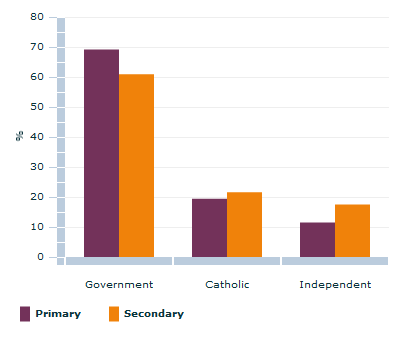 State and territory differences In 2010, student enrolments varied across the states and territories by school affiliation. Reflecting the proportion of government and non-government schools in the states and territories, students were most likely to be enrolled in government schools in the Northern Territory (74%) and least likely to be enrolled in government schools in the Australian Capital Territory (57%). Students in South Australia were the most likely to be enrolled in Independent schools (17%), while students in the Australian Capital Territory were the most likely to be enrolled in Catholic schools (29%). SCHOOL AFFILIATION OF STUDENT BY STATE AND TERRITORY - 2010 This will be replaced by the swf. 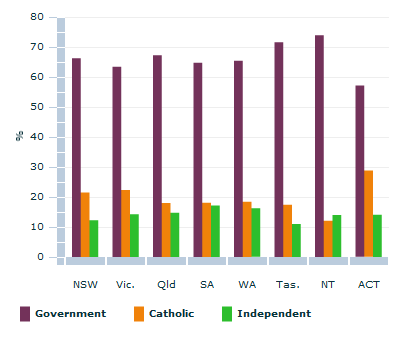 STAFFING As school student numbers have increased, so too have the number of full-time equivalent (FTE) teaching staff. In 2010, there were around 251,000 FTE teaching staff, representing an increase of 15% since 2000 (218,000). Reflecting student enrolment patterns, the rate of increase of FTE teaching staff between 2000 and 2010 was higher in non-government schools (30%) than in government schools (9%). For secondary schools, the increase of FTE teaching staff in non-government schools was five times greater than in government schools (30% compared with 6%). MALE TEACHERS BY SCHOOL AFFILIATION - 2000 AND 2010 This will be replaced by the swf. 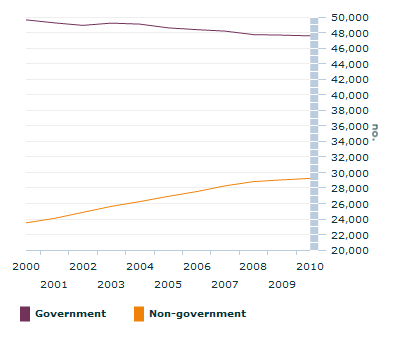 Since 2000, there has been a small increase (5%) in the overall number of male FTE teaching staff across all schools. However, the increase only occurred in non-government schools. Between 2000 and 2010, the number of male FTE teaching staff increased by almost one-quarter (24%) in non-government schools, compared with a decrease of 4% in government schools. Student to teaching staff ratio Full-time equivalent (FTE) student to teaching staff ratios are calculated by dividing the number of full-time students by the number of full-time teaching staff. They are an indicator of the level of staffing resources used in schools and are not a measure of class size. Theoretically, the lower the student to teaching staff ratio, the higher the availability of teacher services to students. (Endnote 4) In general, the student to teaching staff ratio has decreased across all affiliations in the previous 10 years. In 2010, student to teaching staff ratios were lower in government primary schools than non-government primary schools (15.4 compared with 16.5). For secondary schools, the opposite was the case, with lower student to teaching staff ratios in non-government secondary schools (11.7) compared with government secondary schools (12.3). FTE(a) STUDENT TO TEACHING STAFF RATIOS BY SCHOOL AFFILIATION - 2000, 2005 AND 2010 This will be replaced by the swf.  student to teaching staff ratios by school affiliation - 2000, 2005 and 2010.gif) Footnote(s): (a) Full-time equivalent. GOVERNMENT RECURRENT EXPENDITURE ON SCHOOL EDUCATION(A) - 2008-09
Source: Productivity Commission, 2011, Report on Government Services 2011 GOVERNMENT FUNDING All schools receive funding from both the Australian and the state and territory governments, with the proportion of funds received varying between school sectors. Overall, the majority of total public expenditure is allocated to government schools. (Endnote 5) Government schools Under constitutional arrangements, state and territory governments have the responsibility of providing funding for all Australian children of school age. State and territory governments provide the majority of funding to government schools and the Australian government provides supplementary funding under the National Education Agreement (2008). In 2008-09, total government recurrent expenditure on all schools was $38.9 billion. Of this, $30.9 billion was provided to government schools, representing 79% of total government recurrent expenditure on all schools. This was similar to the pattern in 2004-05, where total government recurrent expenditure on government schools represented 78% of total government recurrent expenditure on all schools. In 2008-09, state and territory governments provided 89% of total government recurrent expenditure on government schools and the Australian government provided 11%. Non-government schools The Australian government provides the majority of funding for non-government schools. Under the Schools Assistance Act (2008), based on the funding model introduced in 2001, the Australian government allocates funding according to the socioeconomic status (SES) of the school community. Recently, the equity of this funding model has been the source of public debate, and in mid-2010 the Australian government announced a Review of Funding for Schooling. In March 2011, legislation was passed extending existing non-government school funding to the end of 2013. (Endnote 6) In 2008-09, total government recurrent expenditure on non-government schools was $8.1 billion, representing 21% of total government expenditure on all schools. This reflected a similar pattern seen in 2004-05. Nearly three-quarters (72%) of government recurrent expenditure on non-government schools was provided by the Australian government in 2008-09, with the state and territory governments providing 28%. Private funding Along with government funding, non-government schools also receive significant income from private sources, including fees, charges, donations and income. (Endnote 7) In 2008, private sources accounted for 43% of total non-government school income. In Catholic schools, private sources accounted for 29% of total school income and in Independent schools, private sources accounted for 58% of total school income GOVERNMENT RECURRENT EXPENDITURE PER FTE(a) STUDENT BY SCHOOL AFFILIATION(b) - 2004-05 - 2008-09(c) This will be replaced by the swf.  student by school affiliation(b) - 2004-05 - 2008-09(c).gif) Footnote(s): (a) Full-time equivalent. (b) In 2008–09 real dollars. (c)Year ending 30 June. Source(s): Productivity Commission, 2011, Report on Government Services 2011 Funding per student Government recurrent expenditure per full-time equivalent (FTE) student is measured by dividing total government recurrent expenditure by the total number of FTE students. Holding other factors constant, a low or decreasing government recurrent expenditure per FTE student may represent better or improved efficiency. (Endnote 1) Since 2004-05, government expenditure per FTE student has increased in government schools and decreased in non-government schools. In 2008-09, government recurrent expenditure per FTE student in all schools was $11,260, an increase (in average annual real terms) of 0.4% per year since 2004-05. Government expenditure per FTE student in government schools was $13,544, an increase of 1.2% per year since 2004-05. In comparison, since 2004-05, government expenditure per FTE student in non-government schools decreased by 1.6% per year to $6,850 in 2008-09. On average, total private sources across all non-government schools amounted to $5,400 per student. PATHWAYS Student outcomes are not exclusively determined by the type of school they attended. They may be affected by several factors that lie outside the influence of the school system, such as student commitment, family environment and the proximity of the school to other educational facilities. (Endnote 1) However, there is some argument that the distribution of engaged and achieving students is linked to the better resourcing of some schools over others and the public and parental perceptions of particular schools and sectors. (Endnote 8) The following analysis uses the 2010 ABS Survey of Education and Work to look at the educational outcomes of young adults (15-24 years) who were not currently at school. This analysis only captures the school the young adult last attended and as such does not distinguish between those who may have attended a combination of government and non-government schools over their schooling life. Year 12 attainment Research has shown that those who have completed Year 12 are more likely to continue on to further education as well as enter into the workforce. (Endnote 9) Looking at young adults not currently studying at school in 2010, those who had last attended a non-government school were more likely to have completed Year 12 than those who had last attended a government school (86% compared with 68%). There was little difference between those who last attended Independent schools (88%) and Catholic schools (84%). The same trend could also be observed across Major Cities and Inner/Outer Regional Areas. In Major Cities, young adults who had attended a non-government school were more likely to have attained Year 12 than those who last attended a government school (88% compared with 72%). In Inner/Outer Regional Areas, young adults who had last attended a non-government school were also more likely to have attained Year 12 than those who had last attended a government school (79% compared with 57%). Young men were less likely than young women to have attained Year 12, irrespective of the type of school they last attended. Amongst young adults who last attended a government school, 63% of men had attained Year 12, compared with 73% of women. Amongst young adults who last attended a non-government school, 81% of men and 91% of women had attained Year 12. For further information on Year 12 attainment, please see Year 12 Attainment in Australian Social Trends, March 2011 (cat. no. 4102.0). PEOPLE AGED 15-24 YEARS WITH YEAR 12 BY SCHOOL AFFILIATION(a) AND SEX - 2010 This will be replaced by the swf.  and sex - 2010.gif) Footnote(s): (a) Last school attended, excluding those still at school. Source(s): ABS 2010 Survey of Education and Work Non-school qualifications In 2010, young adults (15-24 years), who were not currently studying at school and who had last attended non-government schools were more likely to be currently studying for, or have already attained, a non-school qualification than those who last attended government schools. ...currently studying Over half (54%) of young adults, who last attended non-government schools, were enrolled in study for a non-school qualification at the time of the survey. In comparison, under two-fifths (39%) of young adults who last attended government schools were enrolled in study for a non-school qualification. There was little difference between the sexes in the proportion who were enrolled in study for a non-school qualification and last attended a government school (38% of men and 39% of women) or a non-government school (53% and 56% respectively). ...attained a non-school qualification Young men were less likely to have attained a non-school qualification than young women. In 2010, 31% of young men who had last attended a government school had attained a non-school qualification compared with 39% of young women. The level of non-school attainment was likely to be higher for those who last attended non-government schools compared with those who had not. For example, of those young adults who had last attended non-government schools and had attained a non-school qualification, 39% had attained a Bachelor degree or above, compared with 25% of those who had last attended government schools. PEOPLE AGED 15-24 YEARS WHO ARE STUDYING FOR, OR HAVE ATTAINED, A NON-SCHOOL QUALIFICATION BY SCHOOL AFFILIATION(a) - 2010 This will be replaced by the swf.  - 2010.gif) Footnote(s): (a) Last school attended, excluding those still at school. Source(s): ABS 2010 Survey of Education and Work LOOKING AHEAD The number of student enrolments and the number of schools have increased more in non-government schools than in government schools. While it has been suggested that this growth is due to the lack of ‘public values’ being taught in government schools, others contend that non-government schools fail to protect these values, instead seeking exclusivity. (Endnote 10) The Council of Australian Governments (COAG) confirmed in the National Education Agreement (2008) that all children should be engaged in, and benefit from, schooling. A sound education at the primary and secondary levels is expected to provide a solid base for further learning experiences and contribute to the development of a skilled workforce. ADDITIONAL TOPICS EXPLANATORY INFORMATION
ENDNOTES 1. Productivity Commission, 2011, Report on Government Services 2011, Chapter 4, School Education, Commonwealth of Australia, Canberra, p. 4.3.2. Department of Education, Employment and Workplace Relations, 9 July 2010, Review of School Funding - Final Terms of Reference, <www.deewr.gov.au>. 3. Australian Curriculum, Assessment and Reporting Authority, 2010, My School, ACARA, Sydney, <www.myschool.edu.au>. 4. Caution should be used when interpreting the student to teaching staff ratio. A low or decreasing student-to-teacher ratio may reflect decreasing efficiency, but may also reflect a higher quality education system, if it is assumed that teachers have more time for each student and that this results in better student outcomes. Student to teaching staff ratio can be affected by several factors, including the proportion of special needs students and the degree to which administrative work is undertaken. 5. All data on government funding is sourced from: Productivity Commission, 2011, Report on Government Services 2011, Chapter 4, School Education, Commonwealth of Australia, Canberra. 6. Department of Education, Employment and Workplace Relations, 2011, School funding certainty a step closer, DEEWR, Canberra, <www.deewr.gov.au>. 7. Data on private funding is sourced from: Harrington, M., 2011, Australian Government funding for schools explained, Department of Parliamentary Services, Parliament of Australia, Canberra, pp. 22-23. 8. Bonner, C., 2011, My School, PISA and Australia’s Equity Gap, Australian Policy Online, Canberra, <www.apo.org.au>, p. 5 and Figure 2. 9. Foundation for Young Australians, 2009, How Young People are Faring 2009, Foundation of Young Australians, Melbourne, p. vii, <www.fya.org.au>.10.Denniss, R., Macintosh, A. and Wilkinson, D., 2004, The Accountability of Private Schools to Public Values, No. 71, The Australian Institute, Melbourne, p. 4. Document Selection These documents will be presented in a new window.
|
||||||||||||||||||||||||||||||||||||||||||||||||||||||||||||||||||||||||||||||||||||||||||||||||||||||||||||||||||||||||||||||||||||||||||||||||||||||||||||||||||||||||||||||||||||||||||||||||||||||||||||||||||||

